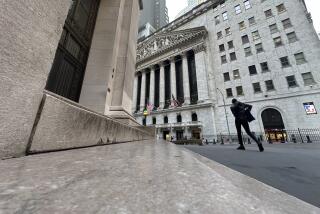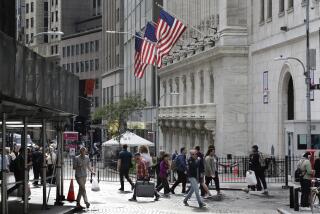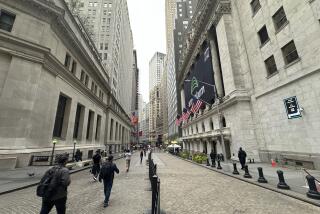STOCKS : Dow Rises 8.16; Buying Shifts to 2nd-Tier Issues
Blue chip stocks closed slightly higher Tuesday, as a scarcity of fresh war news from the Middle East kept trading subdued.
But smaller stocks, including health-care companies, continued to attract investor interest, belying year-end predictions that small stocks would have a tough time rallying early in the new year. They have become the hottest market story this month.
The Dow Jones industrial average advanced 8.16 points, or 0.3%, to 2,662.62. In the broader market, gaining issues outnumbered losing ones by about 6 to 5 in nationwide trading of New York Stock Exchange-listed stocks, with 826 up, 686 down and 482 unchanged.
Big Board volume rose to 155.74 million shares from 141.27 million the day before.
Stock prices opened lower and then seesawed for most of the session. The market remained edgy over the Persian Gulf War but has begun to take a “more forward-looking approach,” said Eugene Peroni, analyst with Janney Montgomery Scott in Philadelphia.
“The (stock) market is not really focusing on the minute-by-minute details from the Middle East,” he said, though any significant news still has the ability to shove the market in either direction. Traders have begun shifting their attention to corporate earnings reports, which are showing varied results, and to the economy.
Most of the buying interest centered on secondary issues. Many investors who began pulling their money out of stocks when the Middle East crisis began to unfold have “some concern about being left out” of the market’s move up, said Hugh Johnson, a senior vice president at First Albany Corp.
The Dow Jones average has advanced more than 150 points over the past two weeks. But because many blue chip issues “appear a bit pricey,” there is “a sense of urgency to buy secondary stocks,” he said.
The NASD composite index of over-the-counter stocks rose 3.81 points, or 1%, to 400.61. It was the index’s first close over 400 since last summer. Since Dec. 31, the index is up 7.2% versus a 1.1% rise for the Dow.
Among the market highlights:
* The OTC stocks leading the market higher included many health-care issues. Health-maintenance organization U.S. Healthcare jumped 3 1/8 to 34 7/8, after soaring 4 on Monday, on positive earnings projections. Other HMOs that jumped included United Healthcare, up 1 1/4 to 28, FHP International, up 1 3/4 to 16 3/4, and PacifiCare, up 2 1/2 to 20.
* Buyers also bid biotech stocks up anew. Amgen rose 1 7/8 to 73 7/8, Biogen added 1/2 to 32 and Genetics Institute gained 2 to 41 3/4.
* Technology-related stocks that went sharply higher included Cadence, up 1 to 25 3/4, Conner Peripherals, up 7/8 to 26 3/4, Autodesk, up 3 1/2 to 45 1/4, Commodore, up 1 1/8 to 14 7/8, and Marshall Industries, up 7/8 to 23 1/4. Storage Technology climbed 2 5/8 to 27 3/4. Analysts cited strong fourth-quarter results and the company’s upbeat outlook during a conference call with analysts.
* Industrial issues were helped by word of a stronger-than-expected jump in durable goods orders, which rose 4.4% in December, above the projected 2.5% gain. Monsanto rose 1 1/8 to 51, Caterpillar gained 1 to 49, Ingersoll-Rand added 1 5/8 to 43 5/8 and Eaton rose 7/8 to 50 1/4.
* McDonald’s lost 1 to 26 3/4. It said Monday that it expects 1991 to be a tougher environment from an economic and competitive standpoint, and Shearson Lehman lowered its 1991 earnings estimate for the company.
* Los Angeles-based financial services firm Broad Inc. rose 7/8 to 6 7/8 after the company reported strong quarterly earnings.
Credit
Bond prices edged higher but trading moved at a glacial pace as traders awaited fresh economic news and action in the Gulf War.
The Treasury’s bellwether 30-year bond climbed 7/32 point, or $2.19 per $1,000 in face amount, at Tuesday’s close. Its yield, which moves in the opposite direction of price, fell to 8.20% from 8.22% late Monday.
Traders offered various reasons for the slightly higher prices. Some said bonds rose in overnight European trading and held their own throughout the day. Others said they were hard-pressed to explain the increase.
The federal funds rate, the interest on overnight loans between banks, fell to 6% from 8% late Monday. The rate dropped after the Federal Reserve entered the market and added reserves to the banking system to bring federal funds to its perceived target of 6.75%, analysts said.
Currency
The dollar lurched higher in domestic trading as an apparent escalation of Persian Gulf hostilities reinvigorated the currency’s appeal as a safe investment.
Tuesday’s currency market reversed a string of bearish sessions and marked the first time in a week that the Middle East conflict has dominated the attention of traders, who said they had been numb to regular reports of Iraqi missile attacks and allied bombing raids.
Currency traders believed that signs of a widening in the conflict came when the Pentagon said about 90 Iraqi fighter-bombers and transport planes--more than one-tenth of the Iraqi air force--flew to Iran in recent days seeking refuge.
Traders said the report seemed to indicate that Iran may get involved in the conflict, leading to a longer and possibly bloodier war than initially anticipated.
In New York, the dollar closed at 1.496 German marks, up from Monday’s 1.487, and 132.14 Japanese yen, up from 131.60. The British pound weaked weakened against the dollar, fetching $1.958, less than late Monday’s $1.965.
Other late dollar rates in New York, compared to late Monday, included: 1.2675 Swiss francs, up from 1.2617; 5.0790 French francs, up from 5.0515; 1,122.75 Italian lire, up from 1,116.25, and 1.1611 Canadian dollars, down from 1.1624.
Commodities
Oil prices jumped nearly $1 per barrel as a new wave of war jitters injected a bit of life into what has been a sluggish futures market.
On other commodity markets, cotton futures surged; soybean futures fell while grains advanced; precious metals were mixed, and livestock and meat futures fell.
Light sweet crude oil for delivery in March settled at $21.85 per barrel, up 89 cents, on the New York Mercantile Exchange. In London, North Sea Brent Blend closed at $20.47 per barrel, up 60 cents, on the International Petroleum Exchange.
Platinum futures recovered some of Monday’s steep losses on the New York Mercantile Exchange on indications of renewed Japanese buying interest and reports of protests in South Africa, the world’s biggest platinum producer, over the loosening of apartheid restrictions.
Platinum settled $3.70 to $3.90 higher, with April at $387.20 an ounce. Meanwhile, on the Commodity Exchange, gold was 20 to 70 cents lower, with February at $376.40 an ounce; silver was 2.5 to 2.6 cents higher, with March at $3.87.
Market Roundup, D6
More to Read
Inside the business of entertainment
The Wide Shot brings you news, analysis and insights on everything from streaming wars to production — and what it all means for the future.
You may occasionally receive promotional content from the Los Angeles Times.










